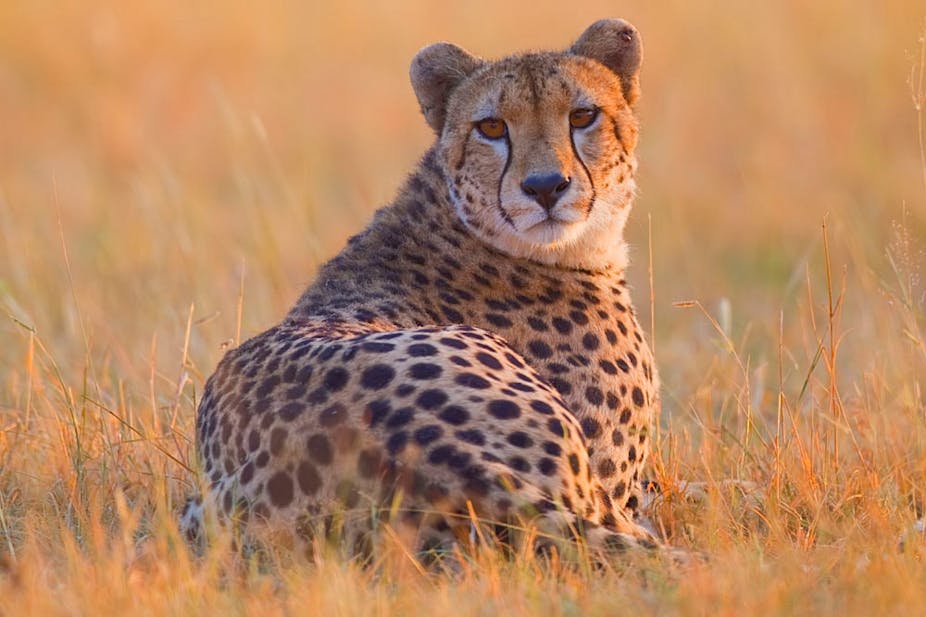Our recent report on global cheetah decline provides alarming reading. Using the best available information, we estimate that there are only about 7,100 wild cheetah left in the world.
The species is now restricted to less than 10% of its historical distribution, and survives in just 33 populations, most of which number fewer than 100 individuals.
Added to this perilous predicament is the fact that most cheetah live outside protected areas. There they face multiple threats including loss of habitat and prey; conflict with livestock and game keepers; and illegal wildlife trade in live cheetah for pets and dead cheetah for skins.
Recent extinctions have been documented in western and central Africa, and there has been an estimated decline of 85% in Zimbabwe over the last 16 years. For cheetah populations where there is sufficient information, most are declining.
This evidence, together with ongoing pressures outside protected areas, led me and 53 co-authors to recommend that the International Union for Conservation of Nature Red List of threatened species up-list the status of cheetah from vulnerable to endangered.
The worsening of the “threat status” of cheetah should act as a wake-up call. Urgent action is needed if the survival of cheetah is to be secured. To put the status of cheetah in perspective, the Serengeti National Park alone safeguards a population of over 3,000 lions – that’s nearly half the global cheetah population.
That there is international public support for cheetah and other iconic megafauna is beyond doubt. This is clear from the millions of international visitors who travel thousands of kilometres to see cheetah and other wildlife, and by the millions who avidly watch wildlife programmes streaming into their homes.
What’s missing is effective means to channel the value into local communities that bear the real costs of living with cheetah and other problematic species.
Challenging to conserve
Cheetah are not the largest cat – they are less than a third the weight of a lion – but they are one of the widest ranging, capable of travelling across areas in excess of 1,000 square kilometres every year. This makes them particularly challenging to conserve.
They move this widely to find their prey and because they need to avoid other large predators, including lion and spotted hyena, which may kill their cubs and steal their kills. But this also means that cheetah occur at much lower densities than other big cats, sometimes seldom exceeding two for every 100 square kilometres. In the Sahara, where a critically endangered population of cheetah still survives, we have documented densities as low as only one cheetah in 4,000 square kilometres.
Thus cheetah need conservation over a much larger scale than is usually seen in terrestrial conservation.
To halt cheetah decline we also have to confront the realities of conservation in developing countries where they still survive. Communities who share their land with cheetah may face a daily challenge just to feed themselves and their families. They cannot afford to pay the costs of losing their precious livestock to cheetah, even if this is a relatively rare event.
Conservation strategies
Much has already been achieved.
Zoological Society of London and Wildlife Conservation Society’s joint Range Wide Conservation Program for Cheetah and African Wild Dog has been working with range state governments for nearly 10 years. They have helped to put in place regional strategies and national action plans that provide a road map for the conservation of cheetah together with African wild dogs. Wild dogs are a species with similar ecology and face similar threats to cheetah.
These strategies and plans have the strong support of range state governments and conservation NGOs and lay out a list of all the actions that need to be undertaken to secure the survival of both species. More financial mechanisms are needed, from range state governments, bilateral and multilateral donors and NGOs, to implement these road maps, and we also need innovative new ways for communities to benefit from the presence of wildlife.
Over coming decades Africa faces a critical period for its biodiversity. The continent’s human population is predicted to double by 2050. The need to support and feed more people will exert unprecedented pressures on wildlife and the environment.
But lessons from Europe show what can be done. Here large carnivores faced imminent extinction towards the end of the 20th century. Yet today, due to protection and restoration programmes combined with policies that help foster coexistence between people and wildlife, there has been a resurgence of bears, wolves and lynx.
People and large carnivores can live together, even when human densities are relatively high.
For cheetah, we urgently need to find the political will and the financial means to enable people and wildlife to coexist, and for both to prosper. Only then can we be sure that future generations will be able to continue to marvel at the sight of a cheetah at full speed. If we fail, the fate of the cheetah will be in doubt.
A version of this article first appeared in the National Geographic Cat Watch blog

